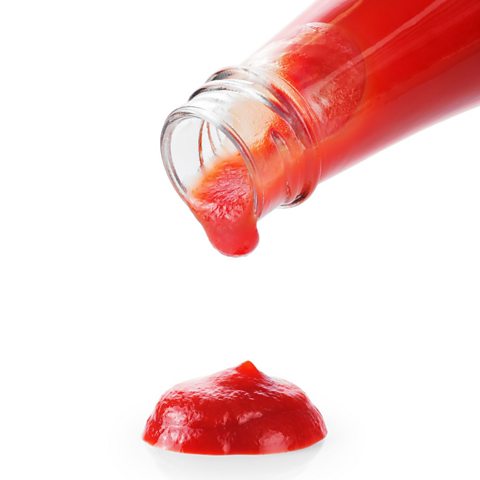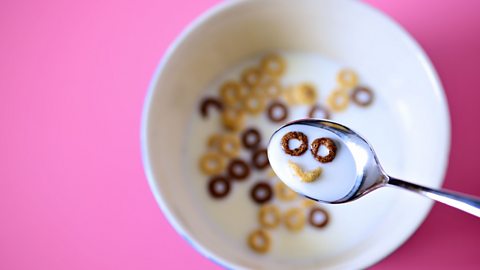Itãs a teatime classic.
Your chips are there, ready to be drowned in ketchupãÎ only for the sauce to stay put in the bottle.
What youãre witnessing isnãt just one of the most frustrating events known to humanity ã itãs also physics in action.
ôÕÑ¿å¥éá Bitesize has looked at four very ordinary events, from doing the laundry to eating cereal, and explained the extraordinary science in them.

Why doesnãt ketchup come out of a glass bottle?
We often classify substances as solid, liquid or gas, but thatãs sometimes a bit of an oversimplification. Ketchup sometimes acts like a liquid (it can flow) but sometimes it acts more like a solid (it keeps its shape to some extent).The thickness of most liquids remains the same even if a force is applied to them. But other liquids can get runnier or thicker, depending on how much force is applied. These substances are called non-Newtonian liquids.
When you apply a force to ketchup it gets runnier, so shaking the bottle makes the ketchup flow more easily out of the bottle ã for a short time, at least! Interestingly, you can make a thick mixture of cornflour and water, known as oobleck, at home and it works the other way round. Applying a force to oobleck by stirring it quickly or squeezing it in your hand makes it more like a solid. Ketchup is a ãshear thinning fluidã and oobleck is a ãshear thickening fluidã.

Why is hot water better at removing stains?
When we heat a substance, the particles that it is made from move more quickly. All chemical reactions, including those that remove dirt and stains from clothes, happen more rapidly at higher temperatures because the faster-moving particles collide more quickly. So when youãre washing clothes with simple chemical detergents, itãs generally the case that higher temperatures mean a cleaner result.
However, most modern laundry detergents contain chemicals called enzymes. Enzymes are made from proteins, and they are found in every single living organism. They speed up chemical reactions, such as those used to digest food or grow new skin cells, inside living things. Enzymes are useful in laundry detergents because they can break down the chemicals in the stains, removing them more quickly. However, almost all enzymes work best at temperatures just below 40 degrees Celsius. So, if your laundry detergent contains enzymes (and most do!), wash at 40 degrees or cooler, and let enzymes do their thing.
A cooler wash is also better for reducing energy consumption, which helps reduce household bills and live more sustainably.

Why does my cereal float to the edge of the bowl?
You might have noticed that when there are only a few pieces of breakfast cereal floating in your bowl, they tend to clump together and sometimes move to the sides. Believe it or not, the tendency for small floating objects to clump together on the surface of water has actually been named the ãCheerios effectã by scientists!
The reason the pieces of breakfast cereal clump together is mainly because of surface tension, which makes the surface of the water behave a bit like a skin. The water rises up at the edges of the bowl ã and the edges of the pieces of cereal ã and this effect is called the meniscus. Because the pieces of cereal are buoyant, they will float as high as possible and therefore they tend to climb up the meniscus to the highest possible points, which are at the edges of the bowl and alongside other floating pieces of cereal.
Interestingly, you can sometimes float non-buoyant objects on the surface tension, like small metal paper clips. The meniscus will then curve downwards towards the objects. Because these objects normally sink, they tend to follow the downwards curving meniscus to the lowest point, bringing them close to other floating paper clips. But they will stay in the middle of the bowl, because they wonãt be able to climb the upwards curving meniscus at the edges of the bowl. Tip: to get a paper clip floating on the surface of water, place it on a fork, near to the end. Gently lower the fork into the water and the paper clip should float. Remove the fork slowly and carefully.

Why can you blow out a candle but winds cause forest fires to spread?
We use the fire triangle to help to explain how to create, prevent or control fires. When most fuels burn, they get the oxygen needed from the air around them, which is approximately 20% oxygen. To begin with, fires need a source of heat, perhaps from a spark, a match or a lighter. Once the fire is burning, the heat energy needed for the fire to continue comes from the fuel that is already burning. If the fire is small, like a candle, then blowing hard on the flame will replace the hot air around the candle with colder air, and will also reduce the temperature of the burning fuel (e.g. the wax). Removing ãheatã from the fire triangle explains why the candle gets blown out.
In a forest fire, the temperatures are incredibly hot. The wind canãt cool them down enough by blowing on them. However, a strong wind can blow the very hot air (and the flames) from one part of the forest to the neighbouring trees, causing them to catch fire too, as well as providing further oxygen to the flames.
This article was published in September 2022
Three 'immortal' creatures that have fascinated scientists for decades
These animals seem to have cracked the code to stop, or even revert, ageing.

Can you ace this science of tennis quiz?
How well do you know the science behind tennis?

What happens when you strike a match in space?
The remarkable things that happen to everyday objects when there's no up and down to be found
